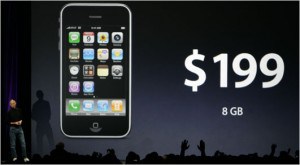When otherwise intelligent writers get sucked into industry propaganda and advocate against their own readers’ best interests, the blowback can become substantial.
VentureBeat is about to learn that principle firsthand as it bungled a piece about wireless carrier mobile data growth into a confusing article claiming “Net Neutrality” will be used by AT&T and Verizon to “drive Sprint and T-Mobile into the ground.”
What?
Authors Tim Chang and Matt Marshall then journey across the landscape of mobile data networks in the United States, regularly stopping to hammer home the requirement for limits on usage, blaming it mostly on online video. The factual potholes litter the landscape, unfortunately:
What that means is the country’s major wireless carriers — Verizon, AT&T, Sprint and T-Mobile — are going to have to abort the all-you-can-eat mobile data plans most of us take for granted. It’s just getting too costly for them to give us the service on their networks for the pricing they offer today.

Video 'is the big problem' justifying Internet Overcharging for wireless mobile data, yet one of the nation's largest providers sees no problem providing its own video service on its network.
Actually, none of these carriers provide unlimited all-you-can-eat mobile data plans. They either explicitly or implicitly (buried in the fine print) limit consumption, usually to 5GB of usage per month. What happens beyond that does vary by carrier. The big four impose overlimit penalties at punishing prices. Some smaller carriers, like Cricket, simply throttle your connection or suspend service on a case-by-case basis.
The reasons for these limits:
- Limited spectrum (the frequencies the provider operates on) may not sustain demand using currently available technology and network design. Could additional spectrum, new technology standards, and more localized delivery of data reduce network congestion?
- Lack of competition. The two primary carriers, AT&T and Verizon, have essentially provided nearly-equivalent pricing. Their robust coverage areas make either a natural choice for most users who travel. Sprint and T-Mobile have larger gaps in coverage. Spectrum auctions, which is how carriers obtain new blocks of frequencies, raise huge sums for the government, but those costs inevitably do get passed down to customers.
- Psychological: Consumers accustomed to limited wireless broadband from the outset are less likely to complain if it is taken away later.
- Economical: Data packages with low limits produce profitable results, with the future possibility of earning even higher profits from subscribers who routinely exceed them and pay penalties and fees, or for carriers to create and market “additional usage packs.”
Jon Metzler, an industry consultant who has conducted research for the CTIA, says he’s heard estimates that a YouTube video of 3-5 minutes costs $1 for a carrier to handle. At this rate, a carrier would be killed when a typical user streams a mere two videos a day. That day is coming soon, because of the race by the smartphones to offer these cool video services.
Of course Metzler works for the CTIA-The Wireless Association, an industry trade and lobbying group. They have a vested interest in pushing the “bandwidth flood” theory to preserve carrier pricing models. The factual basis for this YouTube assertion has been challenged as well, once even by a VentureBeat reader.
Verizon doesn’t see wireless mobile video as the harbinger of doom — it sees it as a feature it can rake profits from, charging $13-25 a month extra for access to VCAST Mobile TV, a Verizon Wireless portal filled with video clips and streams.
It’s always ironic when carriers complain about the impact of services like video, while also heavily marketing their own services that, by their nature, impact their network. YouTube bad, VCAST good.


 Subscribe
Subscribe


